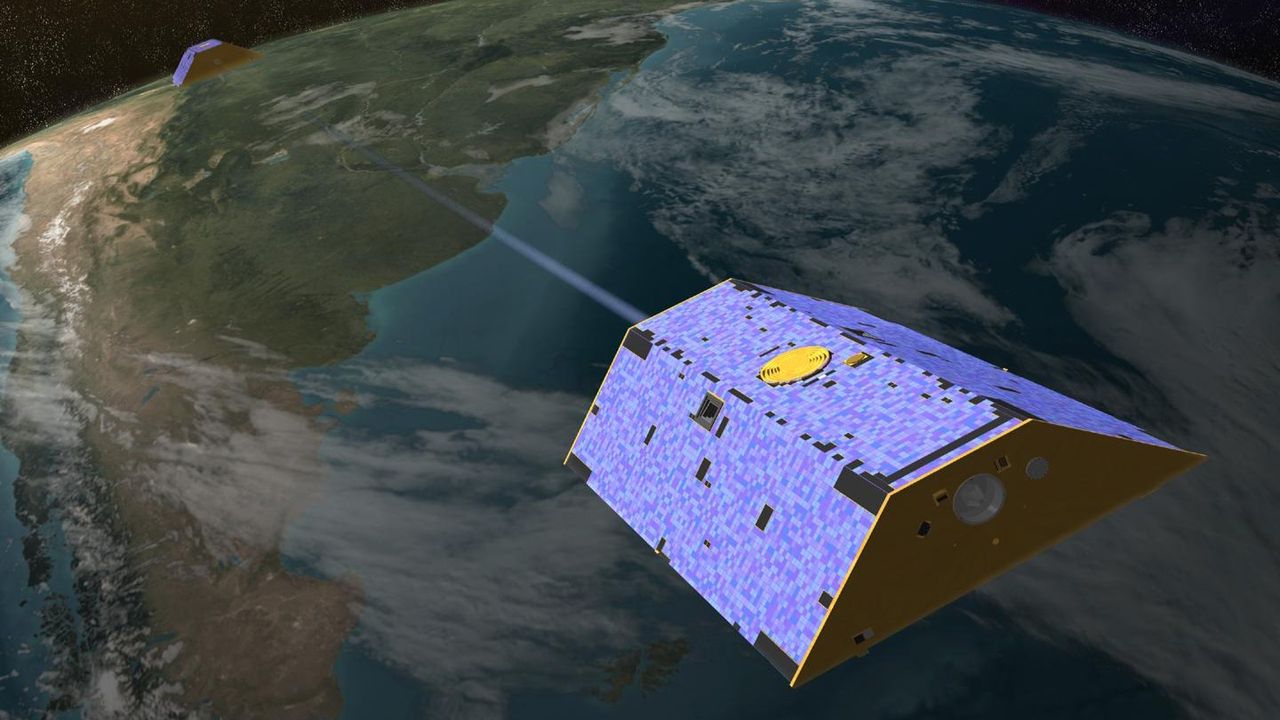Science
Satellites Reveal Unexplained Gravity Anomaly Beneath Earth

Satellites have detected a significant gravitational anomaly beneath the Earth, a finding stemming from data collected nearly two decades ago. This unusual signal, observed off the coast of Africa, suggests that an unknown geological process may have caused a distortion in the planet’s gravitational field. The anomaly peaked in January 2007, coinciding with a notable period in technological history, although there is no connection between the two events.
Researchers recently published their findings in the journal Geophysical Research Letters, after analyzing data from the Gravity Recovery and Climate Experiment (GRACE) satellites. These satellites, a collaborative effort between NASA and the German Aerospace Center (DLR), operated from 2002 until 2017. They measured variations in Earth’s gravity by monitoring the distance between two identical spacecraft as they orbited the planet.
The gravitational anomaly, which lasted approximately two years from 2006 to 2008, extended around 4,350 miles (7,000 kilometers) across the eastern Atlantic Ocean. Researchers believe this anomaly coincided with a geomagnetic “jerk,” an abrupt variation in the Earth’s magnetic field, indicating a correlation between the two phenomena.
The study’s co-author, Mioara Mandea, a geophysicist at the National Centre for Space Studies (CNES), expressed initial skepticism about the signal’s authenticity. In an email, she stated, “As is often the case in scientific research, my initial response was one of questioning: is the signal genuine, how can it be validated, and how should it be interpreted?” Mandea emphasized that while the findings were satisfying, the focus was on understanding their broader implications.
The GRACE mission uniquely allowed scientists to detect gravitational variations caused by shifts in mass concentration within the Earth. Such variations can arise from phenomena such as ocean currents redistributing water mass, but this specific signal suggested a deeper origin, likely from geological processes in the Earth’s mantle.
Researchers theorize that a transformation in the mineral composition of the lower mantle may have led to the rapid redistribution of mass. This involves a phase change from perovskite to post-perovskite structure under extreme pressure conditions. The lower mantle is primarily composed of magnesium silicate (MgSiO3), a compound subject to significant structural changes that can influence gravitational forces.
Mandea highlighted the complexity of Earth’s internal processes, stating, “Earth is a complex system that must be studied using diverse datasets and complementary methods of analysis.” This approach enables scientists to uncover hidden processes within the Earth’s interior, enhancing our understanding of its dynamics.
As researchers continue to explore the depths of our planet, this gravitational anomaly serves as a reminder of the intricate and often mysterious workings beneath our feet. The findings not only contribute to the field of geophysics but also raise questions about the interactions between geological and magnetic phenomena over time.
-

 Lifestyle3 months ago
Lifestyle3 months agoLibraries Challenge Rising E-Book Costs Amid Growing Demand
-

 Sports3 months ago
Sports3 months agoTyreek Hill Responds to Tua Tagovailoa’s Comments on Team Dynamics
-

 Sports3 months ago
Sports3 months agoLiverpool Secures Agreement to Sign Young Striker Will Wright
-

 Lifestyle3 months ago
Lifestyle3 months agoSave Your Split Tomatoes: Expert Tips for Gardeners
-

 Lifestyle3 months ago
Lifestyle3 months agoPrincess Beatrice’s Daughter Athena Joins Siblings at London Parade
-

 World2 months ago
World2 months agoWinter Storms Lash New South Wales with Snow, Flood Risks
-

 Science3 months ago
Science3 months agoTrump Administration Moves to Repeal Key Climate Regulation
-

 Business3 months ago
Business3 months agoSoFi Technologies Shares Slip 2% Following Insider Stock Sale
-

 Science3 months ago
Science3 months agoNew Tool Reveals Link Between Horse Coat Condition and Parasites
-

 Science2 months ago
Science2 months agoSan Francisco Hosts Unique Contest to Identify “Performative Males”
-

 Sports3 months ago
Sports3 months agoElon Musk Sculpture Travels From Utah to Yosemite National Park
-

 Science3 months ago
Science3 months agoNew Study Confirms Humans Transported Stonehenge Bluestones








